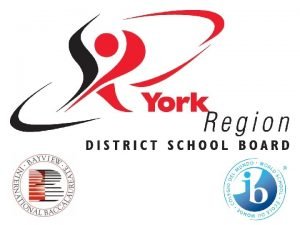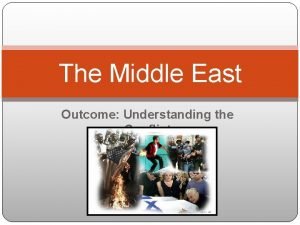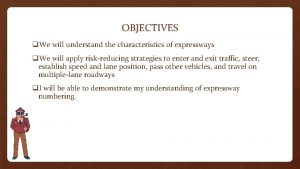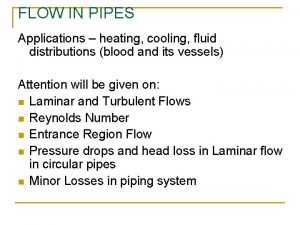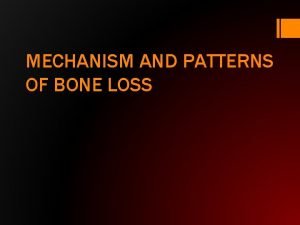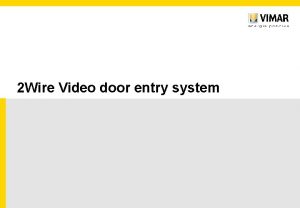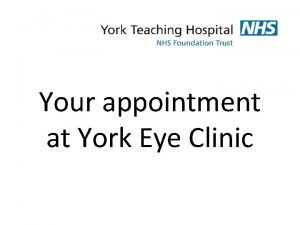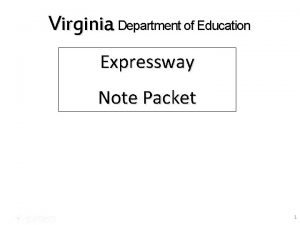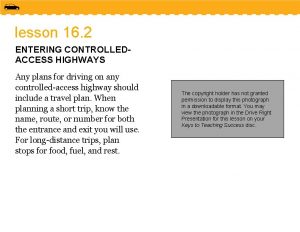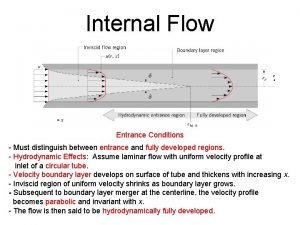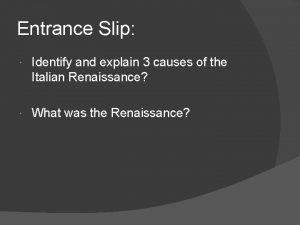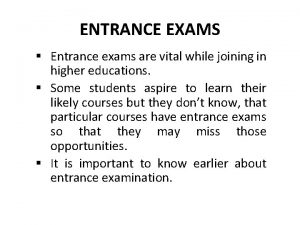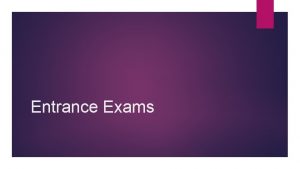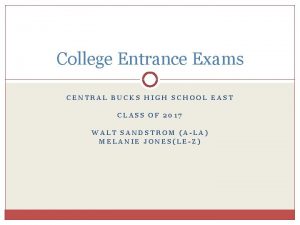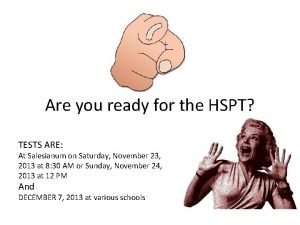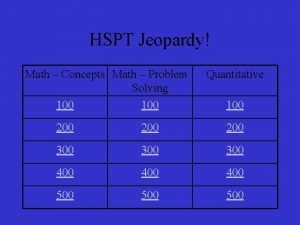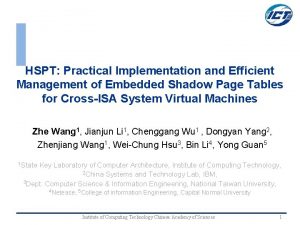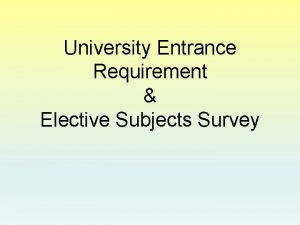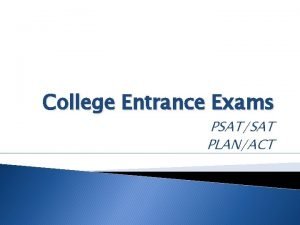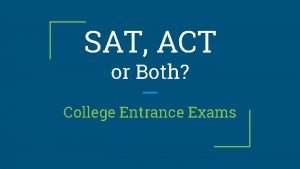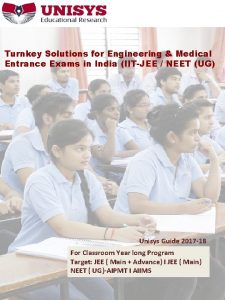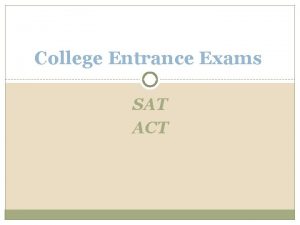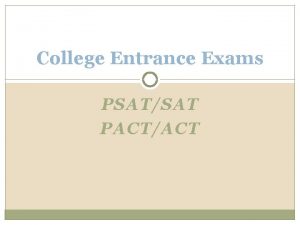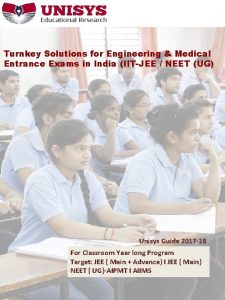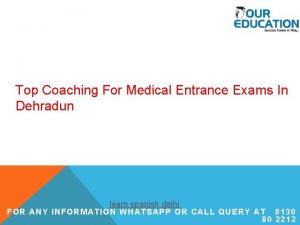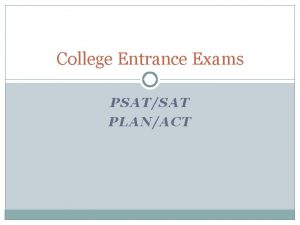High School Entrance Exams ISEE HSPT ISEE the



























- Slides: 27

High School Entrance Exams ISEE & HSPT

ISEE - the breakdown - Sections & Times

What to do when you’re just not sure…

Scoring

What’s a Stanine Again?

Section 1: Verbal Reasoning Synonym (S) questions focus on word recognition, since the correct answer choices are those that have the same meaning, or are closest in meaning, to the word in the question. Synonyms also test your ability to reason, because you must choose the word that is most nearly the same in meaning to the word in the question from among four answer choices.

Strategies: The answer choices are listed in alphabetical order. Think of a word that first comes to mind when you read the synonym and then look for it (or a word like it) in the list. Create your own sentence using the word and try inputting the answer choices into that sentence until one makes the most sense. If a word is unfamiliar, examine the word for roots, prefixes, and suffixes for help deciphering possible word meanings.

Sentence Completion - Single & Paired-Word Responses: Sentence completion questions measure your ability to understand words and their function. Correct answers are based on clues that appear in the context of the sentence. In the Upper Level forms of the ISEE, the sentence completion answer choices are words or pairs of words that logically complete the meaning of the sentence as a whole.

Strategies: FIRST: Read the sentence to get the overall meaning. Focus on keywords or clue words in the question to help you determine the correct answer. Mentally fill in the blank with your own answer and then find the answer choice that is closest in meaning to your own answer. If there are two blanks, the correct answer must be the best answer for both blanks.

Strategies, cont. Remember that there is almost always a word or pair of words that obviously points to the correct answer. Use word clues such as although, because, if, since, or therefore to help you figure out the relationships in the sentence. After you choose your answer, go back and reread the whole sentence to be sure that it makes sense.

Section 3: Reading Comprehension This section of the ISEE contains six reading passages. The passages include topics related to history, science, literature, and contemporary life. Some questions ask you to find a phrase or word in the passage, so all passages show line numbers in the left margin. Each passage is followed by six questions about the passage.

Strategies: Read the passage first to get an overall view. As you read the passage, ask yourself, “What is the main idea? What facts and details are given? ” As you answer the questions following the passage, use the line numbers to help you find the section or lines you may need to look at again. Read the question and think of how you would answer without multiple choice, then see if a close answer exists.

The Six Types of Reading Comprehension Questions: The Main Idea items assess the student’s ability to look for an overall message, theme, or central idea in the passage or section of the passage. The Supporting Ideas items assess the student’s ability to identify explicit ideas that support the main idea or another important concept found in the text. Inference items ask the student to draw a conclusion from content not explicitly stated in the text. Inference items may ask the student to compare and contrast ideas, interpret or analyze text, and/or predict subsequent events or outcomes.

Vocabulary items deal with word definitions within the context of the passage, usually in the form of “most nearly means. ” Organization/Logic items ask students to identify the sequence, pattern, relationship, structure, or summary of the passage and to identify the major features of different literary genres, including narrative, informational, and instructional. Tone/Style/Figurative Language items assess the student’s understanding of mood, tone, point of view, and figurative language such as simile, metaphor, hyperbole, images, irony, and personification.

The Essay Remember that your essay is not scored. Instead, it is shared directly with admissions departments at the schools you have selected. The writing prompts include topics of interest to students at your level and are created to give you an opportunity to tell more about yourself. This part of the test also gives you a chance to show the schools to which you have applied how well you organize your thoughts and express them in a written format.

For the actual ISEE test, you are given a sheet of paper on which to make notes. You MUST rewrite the prompt at the top of the first page! Writing must be done either in cursive or print using a ballpoint pen. The writing should be done directly on the lines preprinted on the two pre-lined pages in the answer document, using blue or black ink(erasable ink is allowed).

You are given 30 minutes to complete the essay. During those 30 minutes you should: • organize your thoughts • prepare your notes or make a short outline • write your final copy

Here is a brief writing checklist designed to help you organize and write in response to the essay topic provided. __ Did I put the topic in the box at the top of the first page, as instructed? __ Did I plan my essay before putting it on the lined sheets? __ Did I allow enough time to write my final copy on the lined sheets? __ Did I write about the topic that was given? __ Did I include details to add interest? __ Did I follow rules for grammar, spelling, punctuation, and capitalization? __ Can others read my handwriting? __ Did I review my writing upon finishing?

Sample Prompts: Topic 1: Of the books you have read in the past year, which one made the biggest impression on you and why? Topic 2: Your school requires you to perform forty hours of community service in order to graduate. Describe which type of community service you would choose and explain your choice. Topic 3: Describe how you define a “truly successful person. ” Explain why, then select a person whom you consider to fit your definition. Why/How are they truly successful, according to your definition?

Test-Taking Tips #1: Answer every question. There is no penalty for wrong answers on the ISEE. So, answer every question, and guess when necessary. Pick the best answer when you can, make strategic guesses when you are able, and for questions you have no idea about or don’t have time for – pick your favorite letter and bubble-in! For every section of multiple-choice, pay enough attention to the limited time to spend the last few minutes of each section marking an answer on your scantron for every single question. The ISEE has many more questions than most students have time to read. Do not leave questions unanswered on your scantron. When you bubble-in an answer without even reading a question, you have a 1/4 chance of answering that question correctly. If you have 20 questions left in a section when time is up but you took a minute to answer them all with your favorite letter – you are likely to get five of them right! Do not miss these easy points on the real ISEE. When you do practice sections, apply this strategy; bubble-in answers to each question so you do not forget! Make time to bubble-in an answer for every question on the ISEE!

#2: Fend off discouragement! The ISEE is not similar to a test you take in school. On an in-class exam, you are expected to know most or all of the information on the test because it has been taught. The ISEE is different. It is not a test of taught information in the same way. The ISEE is made to be so difficult that almost no one gets most of the answers correct. For example, the Upper Level ISEE is made for current 8 th through 11 th graders applying to private schools. So, if you are a 9 th grader taking this test, please understand it is made to also challenge students older than you. No one who takes the ISEE should expect to even have time to read all the questions, much less to get them all correct. So please adjust your expectations. Do not think of the ISEE as similar to a test in school where you can work to get an ‘A. ’ On the ISEE, you can get many questions wrong and still do very well; you are compared only to other students at your grade level. Do not get discouraged because the ISEE is “too hard. ” It is way “too hard” for almost everyone. Learn the strategies, apply them as well as you can, practice, and relax on test day knowing you have done what you can to succeed.

#3: THINK of the answer before reading answer choices! On the verbal sections of the ISEE and for quantitative reasoning (and for some mathematics achievement) questions, when possible, it is important that you do not read answer choices before coming up with your own answer to each question. There are certainly exceptions; for example, there are questions in Critical Reading that say, “Which of the following…, ” which require you to read answer choices first. But whenever possible, predict the answer before reading choices A, B, C, or D. There is more advice under each section type for how best to do this for synonyms, sentence completions, etc. Many wrong answer choices on the ISEE represent common mistakes and misconceptions; many wrong answer choices often look tempting. Even if you misunderstand a question, you will likely find the answer choice you are thinking of among the answer choices. This is an important reason to avoid reading answer choices until absolutely necessary; they can mislead you!

THE HSPT TEST There is no “passing” score to the HSPT, but you will need to know what the cut off average score is for the schools to which you’re looking to apply. For this information, check their website, or call, and they’ll tell you the average score of students who are accepted.

Verbal Skills Which of these does not belong? _____ most nearly means… _____ is to ____ as _____ is to ____. If the first two statements are true, the third is (True/False/Uncertain) A _____ is. ______ is the opposite of _____ means the same as _____.

Reading Comprehension VERY similar to ISEE. Use same strategies!! One major difference: Reading Vocabulary is its own portion of the test.

The Language Test The main errors the test will throw at you include: Possessive Nouns Comma Errors Pronoun/Antecedent Agreement Tenses Homonyms Proper Usage (I/Me; There/Their/They’re, etc. )

Finally:
 Patrimonio netto isee
Patrimonio netto isee Compensi sportivi isee 2020
Compensi sportivi isee 2020 Abbonamento ataf isee
Abbonamento ataf isee Dove si legge il valore isee
Dove si legge il valore isee Bayview ib program registration
Bayview ib program registration Crescenta valley high school graduation 2021
Crescenta valley high school graduation 2021 Haltom high school summer school
Haltom high school summer school Module 5 topic 3 hills and mountains
Module 5 topic 3 hills and mountains Entrance hidden by bricks and rubble
Entrance hidden by bricks and rubble Dry bench in dark room
Dry bench in dark room Emphasis là loại hoạt cảnh gì
Emphasis là loại hoạt cảnh gì What are the three parts of an expressway entrance?
What are the three parts of an expressway entrance? Inward projecting pipe entrance
Inward projecting pipe entrance Entrance culvert
Entrance culvert Construction entrance
Construction entrance Entrance antiphon for today
Entrance antiphon for today Reversed architecture bone loss
Reversed architecture bone loss Bullet entrance and exit holes
Bullet entrance and exit holes 2 wires video entrance panels
2 wires video entrance panels York hospital eye clinic
York hospital eye clinic Expressway entrance components
Expressway entrance components An organization providing an entrance ramp to internet
An organization providing an entrance ramp to internet Math placement test yale
Math placement test yale Prayer before taking entrance exam
Prayer before taking entrance exam Highway with short entrance lane
Highway with short entrance lane Fully developed flow
Fully developed flow Entrance slip
Entrance slip Easter entrance hymns
Easter entrance hymns




